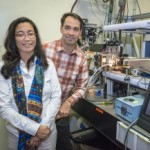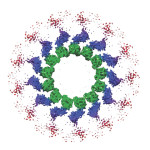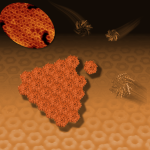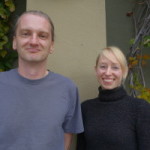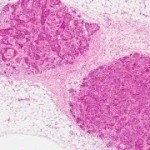The potential of modular design for brand new proteins that do not yet exist in the natural world are the latest in a recent series of developments toward custom-designing proteins. Scientists with the University of Washington used the Berkeley Lab Advanced Light Source (ALS) for some of their research. They collaborated with Susan Tsutakawa , Greg Hura, and Kathryn Burnett, of the Molecular Biophysics & Integrated Bioimaging Division, who work at the ALS beamline SIBYLS where some crystallography studies of repeat protein molecule structures took place.
Single-Particle Cryo-Electron Microscopy Named Method of the Year
Nature Methods recognized the technology for “its newfound ability to determine challenging protein and protein-complex structures at high resolution.” In the journal, the Lab’s Eva Nogales and Robert Glaeser comment on cryo-EM and technological advancements that provide near-atomic resolutions of protein structures without the need for crystallization. The announcement has links to the Nogales and Glaeser Commentaries.
Nature’s Microscopic Masonry: The First Steps in How Thin Protein Sheets Form Polyhedral Shells
Scientists for the first time have viewed how bacterial proteins self-assemble into thin sheets and begin to form the walls of the outer shell for nano-sized polyhedral compartments that function as specialized factories. Researchers in the Molecular Biophysics & Integrated Bioimaging Division determined the 3-D structure of the basic building block protein from crystallized samples in the Berkeley Center for Structural Biology at the Advanced Light Source. Their findings may eventually help improve drug delivery systems. Read more in the Berkeley Lab News Center.
Lab-Developed Beamline Tool Licensed
A diode beamstop technology for real time X-ray beam intensity measurement, developed by Diane Bryant and Simon Morton at the Berkeley Center for Structural Biology, was licensed to MiTeGen, which will commercialize a product to enhance X-ray beamlines used for pharma, materials, and biotech research. The Innovation and Partnerships Office managed the licensing process. Read more at IPO.
Berkeley Lab Researchers Develop New Weapon in the Fight Against Breast Cancer
Mina Bissell, Curt Hines, and Irene Kuhn of the Biological Systems & Engineering Division led the development of the first clinically-relevant mouse model of human breast cancer to successfully express functional estrogen receptor positive adenocarcinomas. This model should be a powerful tool for testing therapies for aggressive ER+ breast cancers and for studying luminal cancers. Read more at the Berkeley Lab News Center.
- « Previous Page
- 1
- …
- 200
- 201
- 202
- 203
- 204
- …
- 213
- Next Page »
Was this page useful?


